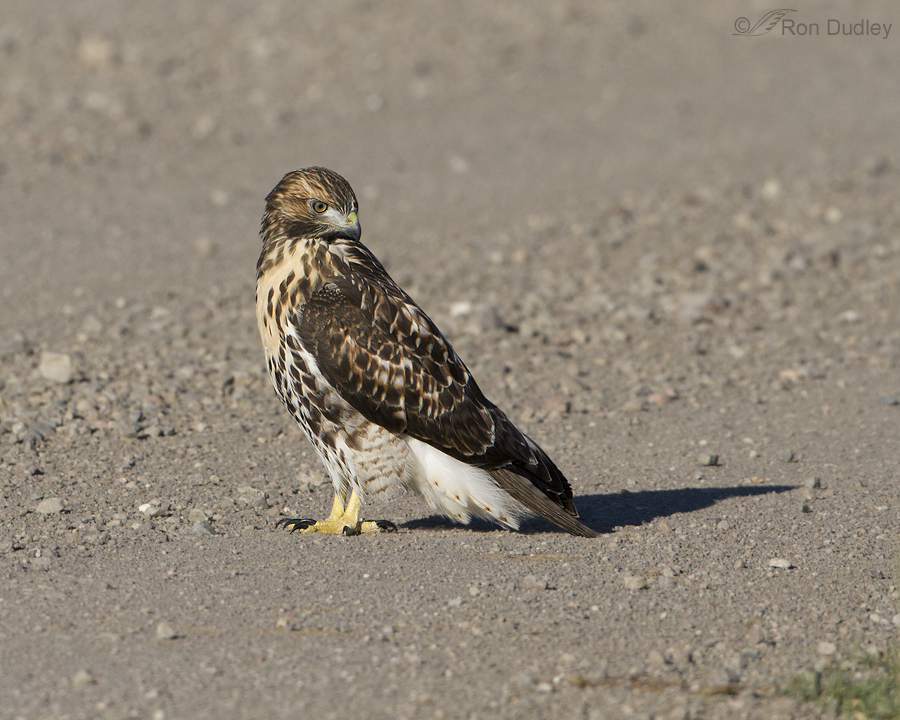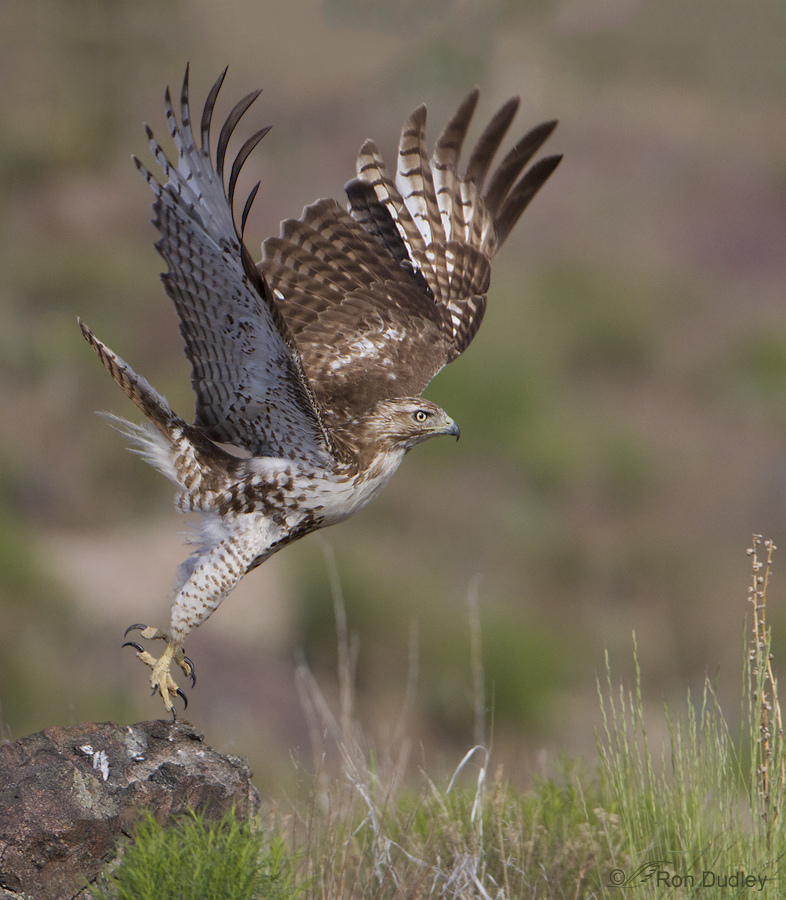Tag: buteo jamaicensis
A Red-tailed Bon Voyage
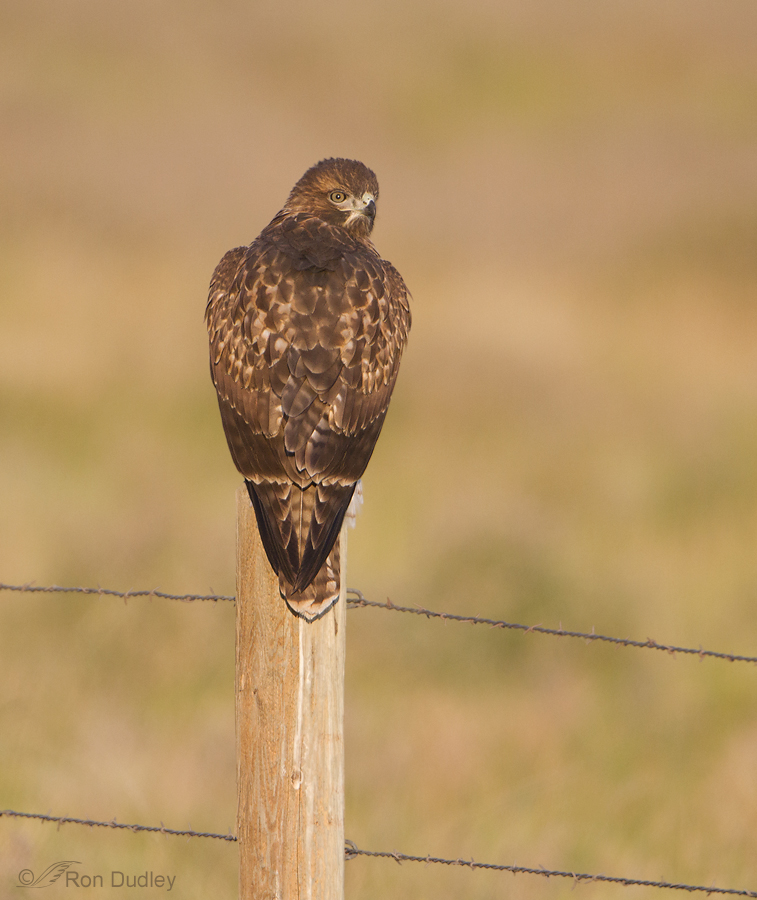
Typically I don’t have high hopes of getting any decent shots during the almost 30 mile drive on a dirt/gravel road from our usual camping spot to the first paved road. Imagine if you can the noise, the dust and the bird-scattering spectacle of my pickup and camping trailer rattling down the rocky road – a situation not conducive to getting anywhere near spooky birds.
Red-tailed Hawks – Creatures Of Habit
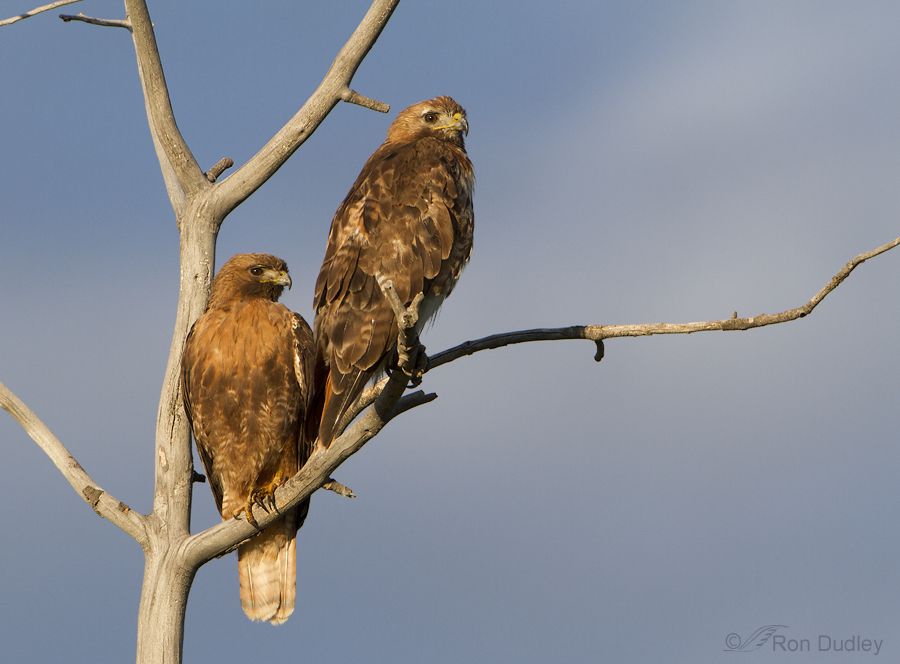
Last summer (these first two photos were taken July 22, 2012) I photographed this mated pair of Red-tailed Hawks in western Montana. On most mornings and some evenings I could almost count on finding them perched in the same old snag and even on the same branch of the dead tree.
Earlier this month on my first Montana camping trip I found the same mated pair on the same perch (male at bottom, female up top).
Why The Cloning Tool Can Be Such A Temptress
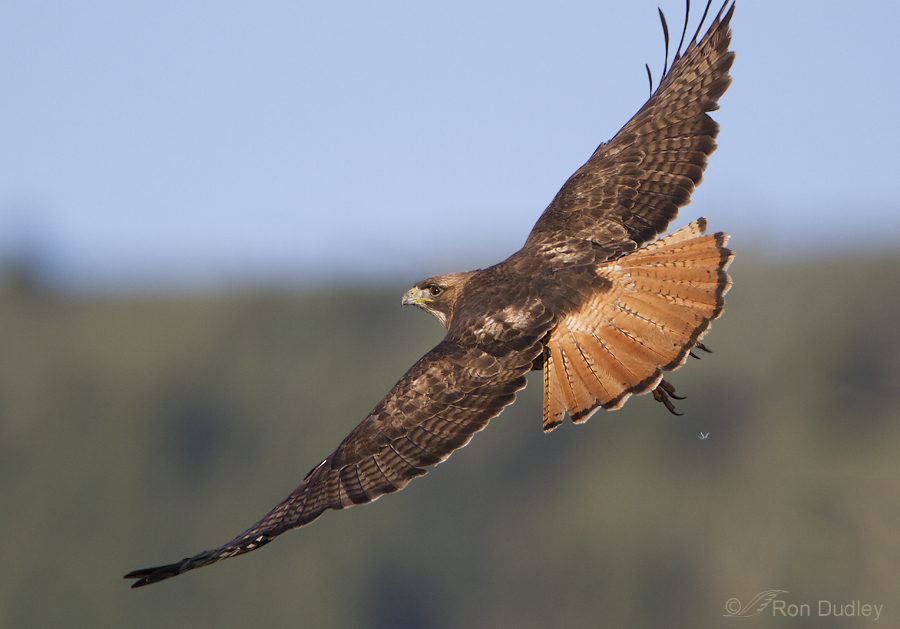
This Red-tailed Hawk image from last week in Montana is an example of what I’m nearly always hoping to get when I’m on a perched raptor while it’s facing away from me and about to take off. 99+% of the time all you’ll get is a butt shot but if you’re extremely (and I do mean extremely) lucky you’ll get a nice look back from the bird as it banks, a widely flared and beautiful tail, good light on the entire dorsal surface, light in the eye and maybe even something interesting in the background other than featureless sky. And this time there was the bonus of a small falling feather below the left foot (something I like but others may find distracting).
Red-tailed Hawk – A Twisting Take-off After Prey
The sturdy, broad-winged buteos tend to be large raptors with correspondingly slower movements than most smaller birds. Most of the time when I’m watching them they’re hunting from an elevated perch or soaring overhead and in neither situation do they typically demonstrate much quickness or agility.
But they can put on quite the show when they need to.
Light Red-tailed Hawk
A Bird Photographer’s Conundrum – Red-tailed Hawk
Sunday morning we visited Utah’s west desert to see what we could turn up out there. We found a pair of American Kestrels, a few Swainson’s Hawks, one Ferruginous Hawk, several Turkey Vultures apparently feeding on a dead calf and four Red-tailed Hawks. But most were difficult to approach, in bad light or on ugly perches. Note: Some of this post may be of interest only to photographers. I apologize in advance to those of you interested more in the results of bird photography than in the process… 1/2500, f/6.3, ISO 640, 500 f/4, natural light, not baited, set up or called in But we did find the nesting pair of red-tails that I’ve posted about previously. This bird was perched up a canyon near the nest where its mate was incubating eggs. I caught the hawk at lift-off… 1/2500, f/6.3, ISO 640, 500 f/4, natural light, not baited, set up or called in and immediately after… 1/2500, f/6.3, ISO 640, 500 f/4, natural light, not baited, set up or called in and I was able to keep the bird in focus for a long burst of 22 images as it flew to my left. The problem was that it had been perched above me on a hill so when it took off it mostly glided with its wings straight out and shaded underneath so many of those shots aren’t particularly interesting. 1/2500, f/6.3, ISO 640, 500 f/4, natural light, not baited, set up or called in This was the last image with any light under the wings….
How Can This Hawk Even Fly?
This might just be the rattiest looking raptor I’ve ever encountered in the wild.
I found this juvenile Red-tailed Hawk three days ago in Box Elder County, Utah. It was too far away for good photos but even so I scoped it out with my lens for ID and to look for anything unusual.
West Desert Red-tailed Hawk
I spotted this adult Red-tailed Hawk perched on the side of a hill and hoped to get some take-off shots as it lifted off and then perhaps some full flight images. I always try to anticipate direction of take-off in this type of situation and I was pretty sure it would lift off to my left in the direction it’s facing. But I was wrong…
Red-tailed Hawk Lift-off Sequence
This past fall I spent several days photographing a couple of juvenile Red-tailed Hawks on Antelope Island. I suspect they were siblings as they seemed to enjoy each others company, though one of them was significantly more skittish than the other. This one was the more cooperative of the two. I enjoy the challenge of lift-off sequences. I usually consider myself lucky if I can get 2-3 sharp shots with poses I like before losing focus on the bird but this time I did better than usual. There won’t be much “narration” here, just a series of images as the hawk took off after prey. Some of the shots are a little sharper than others but I like seeing the entire sequence – “warts” and all. Techs for all these images were identical – 1/2000, f/7.1, ISO 400, 500 f/4, 1.4 tc, natural light, not baited, set up or called in. Moment of lift-off. I like the splayed feet. Here the nictitating membrane is partially closed. Compositionally the left wing is too tight at the top of this image. I could easily add canvas up there and I might. I like how they splay their tail during the wing down-beat at take-off. Normally I do very little cloning but in this case I’d probably remove the stem under the bird if I chose to print this image. I did add a little canvas at the bottom of this shot. These last two images are very similar but I include them to…
Red-tailed Hawk – Intensity At Take-off
Raptors at take-off typically have a “focused” look about them – they’re all business. But I thought the intensity of purpose of this Red-tailed Hawk was particularly evident. 1/3200, f/7.1, ISO 500, 500 f/4, 1.4 tc, natural light, not baited, set up or called in Red-tails are “perch-and-wait” hunters so when they take off after prey they already have their eye on it and their focus is seldom diverted as they swoop in for the kill. This juvenile was hunting voles from an elevated rock perch on Antelope Island several months ago. I’ve had few opportunities with red-tails since all the snow piled up around here. Hopefully that will soon change… Ron
Harlan’s Hawk On A Coot Kill (graphic)
On January 18 I photographed this Harlan’s Hawk at Farmington Bay WMA. Harlan’s is a relatively rare and very dark subspecies of the Red-tailed Hawk that breeds in Alaska and northern Canada but winters in the western U.S. and the Great Plains. I posted two other shots of this bird on January 20. 1/3200, f/7.1, ISO 400, 500 f/4, 1.4 tc, natural light, not baited, set up or called in On this day I only had a few moments with the hawk before it took off. 1/2500, f/8, ISO 500, 500 f/4, natural light, not baited, set up or called in Then, on January 22, we located the bird once again within just a few yards of where it had been four days earlier. This time it was at the bottom of a creek gully feeding on a freshly killed American Coot. The angle was steep and it’s not the most attractive setting but the behavior was interesting so I took lots of photos of this juvenile, if for no other reason than documentation of an unusual bird enjoying a meal. 1/2500, f/8, ISO 500, 500 f/4, natural light, not baited, set up or called in The bird was only nervous with our presence for a few moments, then resumed eating its meal with enthusiasm. Here it has a beak-full of feathers that it had a difficult time shaking off. 1/2000, f/7.1, ISO 500, 500 f/4, natural light, not baited, set up or called in I spent over 5 minutes with this…
Harlan’s Hawk
Harlan’s Hawk is today considered to be a sub-species of the Red-tailed Hawk but its classification has a colorful history as it has twice been considered a separate species and twice as a race of the Red-tailed Hawk. The controversy continues today as several “experts” lobby to have the Harlan’s reinstated as a distinct species. In 1831 John James Audubon originally named this bird Harlan’s Buzzard, after his good friend Dr. Richard Harlan of Philadelphia. 1/2000, f/7.1, ISO 400, 500 f/4, 1.4 tc, natural light, not baited, set up or called in Harlan’s Hawks are quite similar to western Red-tailed Hawks but typically they are “colder/blacker” in overall color, with the tendency toward dusky-white tails in the ventral view. At rest, wing tips are obviously shorter than tail tips (easily seen here) and their breasts are variably streaked with white. 1/2000, f/7.1, ISO 400, 500 f/4, 1.4 tc, natural light, not baited, set up or called in In this view you can make out another identifying feature – the barring to the tips of the wing primaries (most easily seen here in the left wing). Harlan’s Hawks are found in Alaska and northern Canada but winter in the western United States and the Great Plains. I’ve had very few (if any) photo opportunities with them but found this juvenile (light eye) two days ago at Farmington Bay. I’m always delighted to photograph a “new” bird, particularly when it’s a raptor. Ron
Poop, Perches and Personal Preferences
Many raptors are “sit and wait” hunters, which means they often hunt from an elevated perch instead of “on the wing” and Red-tailed Hawks are well-known for this practice. An elevated perch provides good views over a large area and no extra energy need be expended in flight while looking for food. Typically these birds will use the same productive perch repeatedly over long periods of time, which presents a challenge to the photographer – poop (hereafter referred to as “whitewash”). Whitewash consists largely of crystalline uric acid (it’s more complicated than that but I’ll try not to stray into a discussion of the functions of the cloaca), which tends to be bright white. That whitewash can create some aesthetic and ethical conflicts between a “natural shot” and an image that has been “Photoshopped” to death, primarily by use of the clone tool. Many photographers routinely clone out whitewash and/or droppings and I’ll admit that I’ve done it before, but for me it’s an ethical dilemma because I much prefer to leave my images as natural as possible since I consider myself to be a “nature photographer”. In fact, right now I’m struggling with a series of Horned Lark images that I really like, but there’s a large, fresh and very conspicuous dropping right in front of the birds foot that most would find distracting. I could clone it out but every time I looked at that image I would know what I’d done. Canon 7D, 1/4000, f/5.6, ISO 640, 500 f/4, natural light, not baited, set up or called in A couple of days…
Juvenile Red-tailed Hawk
For several days early last month I was able to photograph this juvenile Red-tailed Hawk (and occasionally its apparent sibling) while it was “sit and wait” hunting for voles from elevated rocks on Antelope Island. The first six images I’ve presented here were all taken on the same morning. 1/2000, f/7.1, ISO 400, 500 f/4, 1.4 tc, natural light, not baited, set up or called in Many of these shots were taken during or just after take-off and you’ll notice that the bird was flying to my left in all six images taken that morning. That’s due to the “lay of the land” and the fact that the rocks this bird was hunting from were angled on the side of the mountain in such a way that the hawk was always hunting an area to my left. This is one of the few times the bird took off when it wasn’t after prey. 1/3200, f/6.3, ISO 400, 500 f/4, natural light, not baited, set up or called in When the hawk had spotted prey before it took off it never took its eyes off the quarry as it was going in, so I normally wouldn’t get direct eye contact. This bird was very close when it took off – you’ll notice from my techs that I’d removed my tc and the hawk was still quite large in the frame. 1/2000, f/6.3, ISO 500, 500 f/4, 1.4 tc, natural light, not baited, set up or called in It was somewhat problematic when there were rocks directly behind the…
A Red-tailed Bon Voyage

Typically I don’t have high hopes of getting any decent shots during the almost 30 mile drive on a dirt/gravel road from our usual camping spot to the first paved road. Imagine if you can the noise, the dust and the bird-scattering spectacle of my pickup and camping trailer rattling down the rocky road – a situation not conducive to getting anywhere near spooky birds.
Red-tailed Hawks – Creatures Of Habit

Last summer (these first two photos were taken July 22, 2012) I photographed this mated pair of Red-tailed Hawks in western Montana. On most mornings and some evenings I could almost count on finding them perched in the same old snag and even on the same branch of the dead tree.
Earlier this month on my first Montana camping trip I found the same mated pair on the same perch (male at bottom, female up top).
Why The Cloning Tool Can Be Such A Temptress

This Red-tailed Hawk image from last week in Montana is an example of what I’m nearly always hoping to get when I’m on a perched raptor while it’s facing away from me and about to take off. 99+% of the time all you’ll get is a butt shot but if you’re extremely (and I do mean extremely) lucky you’ll get a nice look back from the bird as it banks, a widely flared and beautiful tail, good light on the entire dorsal surface, light in the eye and maybe even something interesting in the background other than featureless sky. And this time there was the bonus of a small falling feather below the left foot (something I like but others may find distracting).
Red-tailed Hawk – A Twisting Take-off After Prey
The sturdy, broad-winged buteos tend to be large raptors with correspondingly slower movements than most smaller birds. Most of the time when I’m watching them they’re hunting from an elevated perch or soaring overhead and in neither situation do they typically demonstrate much quickness or agility.
But they can put on quite the show when they need to.
Light Red-tailed Hawk
A Bird Photographer’s Conundrum – Red-tailed Hawk
Sunday morning we visited Utah’s west desert to see what we could turn up out there. We found a pair of American Kestrels, a few Swainson’s Hawks, one Ferruginous Hawk, several Turkey Vultures apparently feeding on a dead calf and four Red-tailed Hawks. But most were difficult to approach, in bad light or on ugly perches. Note: Some of this post may be of interest only to photographers. I apologize in advance to those of you interested more in the results of bird photography than in the process… 1/2500, f/6.3, ISO 640, 500 f/4, natural light, not baited, set up or called in But we did find the nesting pair of red-tails that I’ve posted about previously. This bird was perched up a canyon near the nest where its mate was incubating eggs. I caught the hawk at lift-off… 1/2500, f/6.3, ISO 640, 500 f/4, natural light, not baited, set up or called in and immediately after… 1/2500, f/6.3, ISO 640, 500 f/4, natural light, not baited, set up or called in and I was able to keep the bird in focus for a long burst of 22 images as it flew to my left. The problem was that it had been perched above me on a hill so when it took off it mostly glided with its wings straight out and shaded underneath so many of those shots aren’t particularly interesting. 1/2500, f/6.3, ISO 640, 500 f/4, natural light, not baited, set up or called in This was the last image with any light under the wings….
How Can This Hawk Even Fly?
This might just be the rattiest looking raptor I’ve ever encountered in the wild.
I found this juvenile Red-tailed Hawk three days ago in Box Elder County, Utah. It was too far away for good photos but even so I scoped it out with my lens for ID and to look for anything unusual.
West Desert Red-tailed Hawk
I spotted this adult Red-tailed Hawk perched on the side of a hill and hoped to get some take-off shots as it lifted off and then perhaps some full flight images. I always try to anticipate direction of take-off in this type of situation and I was pretty sure it would lift off to my left in the direction it’s facing. But I was wrong…
Red-tailed Hawk Lift-off Sequence
This past fall I spent several days photographing a couple of juvenile Red-tailed Hawks on Antelope Island. I suspect they were siblings as they seemed to enjoy each others company, though one of them was significantly more skittish than the other. This one was the more cooperative of the two. I enjoy the challenge of lift-off sequences. I usually consider myself lucky if I can get 2-3 sharp shots with poses I like before losing focus on the bird but this time I did better than usual. There won’t be much “narration” here, just a series of images as the hawk took off after prey. Some of the shots are a little sharper than others but I like seeing the entire sequence – “warts” and all. Techs for all these images were identical – 1/2000, f/7.1, ISO 400, 500 f/4, 1.4 tc, natural light, not baited, set up or called in. Moment of lift-off. I like the splayed feet. Here the nictitating membrane is partially closed. Compositionally the left wing is too tight at the top of this image. I could easily add canvas up there and I might. I like how they splay their tail during the wing down-beat at take-off. Normally I do very little cloning but in this case I’d probably remove the stem under the bird if I chose to print this image. I did add a little canvas at the bottom of this shot. These last two images are very similar but I include them to…
Red-tailed Hawk – Intensity At Take-off
Raptors at take-off typically have a “focused” look about them – they’re all business. But I thought the intensity of purpose of this Red-tailed Hawk was particularly evident. 1/3200, f/7.1, ISO 500, 500 f/4, 1.4 tc, natural light, not baited, set up or called in Red-tails are “perch-and-wait” hunters so when they take off after prey they already have their eye on it and their focus is seldom diverted as they swoop in for the kill. This juvenile was hunting voles from an elevated rock perch on Antelope Island several months ago. I’ve had few opportunities with red-tails since all the snow piled up around here. Hopefully that will soon change… Ron
Harlan’s Hawk On A Coot Kill (graphic)
On January 18 I photographed this Harlan’s Hawk at Farmington Bay WMA. Harlan’s is a relatively rare and very dark subspecies of the Red-tailed Hawk that breeds in Alaska and northern Canada but winters in the western U.S. and the Great Plains. I posted two other shots of this bird on January 20. 1/3200, f/7.1, ISO 400, 500 f/4, 1.4 tc, natural light, not baited, set up or called in On this day I only had a few moments with the hawk before it took off. 1/2500, f/8, ISO 500, 500 f/4, natural light, not baited, set up or called in Then, on January 22, we located the bird once again within just a few yards of where it had been four days earlier. This time it was at the bottom of a creek gully feeding on a freshly killed American Coot. The angle was steep and it’s not the most attractive setting but the behavior was interesting so I took lots of photos of this juvenile, if for no other reason than documentation of an unusual bird enjoying a meal. 1/2500, f/8, ISO 500, 500 f/4, natural light, not baited, set up or called in The bird was only nervous with our presence for a few moments, then resumed eating its meal with enthusiasm. Here it has a beak-full of feathers that it had a difficult time shaking off. 1/2000, f/7.1, ISO 500, 500 f/4, natural light, not baited, set up or called in I spent over 5 minutes with this…
Harlan’s Hawk
Harlan’s Hawk is today considered to be a sub-species of the Red-tailed Hawk but its classification has a colorful history as it has twice been considered a separate species and twice as a race of the Red-tailed Hawk. The controversy continues today as several “experts” lobby to have the Harlan’s reinstated as a distinct species. In 1831 John James Audubon originally named this bird Harlan’s Buzzard, after his good friend Dr. Richard Harlan of Philadelphia. 1/2000, f/7.1, ISO 400, 500 f/4, 1.4 tc, natural light, not baited, set up or called in Harlan’s Hawks are quite similar to western Red-tailed Hawks but typically they are “colder/blacker” in overall color, with the tendency toward dusky-white tails in the ventral view. At rest, wing tips are obviously shorter than tail tips (easily seen here) and their breasts are variably streaked with white. 1/2000, f/7.1, ISO 400, 500 f/4, 1.4 tc, natural light, not baited, set up or called in In this view you can make out another identifying feature – the barring to the tips of the wing primaries (most easily seen here in the left wing). Harlan’s Hawks are found in Alaska and northern Canada but winter in the western United States and the Great Plains. I’ve had very few (if any) photo opportunities with them but found this juvenile (light eye) two days ago at Farmington Bay. I’m always delighted to photograph a “new” bird, particularly when it’s a raptor. Ron
Poop, Perches and Personal Preferences
Many raptors are “sit and wait” hunters, which means they often hunt from an elevated perch instead of “on the wing” and Red-tailed Hawks are well-known for this practice. An elevated perch provides good views over a large area and no extra energy need be expended in flight while looking for food. Typically these birds will use the same productive perch repeatedly over long periods of time, which presents a challenge to the photographer – poop (hereafter referred to as “whitewash”). Whitewash consists largely of crystalline uric acid (it’s more complicated than that but I’ll try not to stray into a discussion of the functions of the cloaca), which tends to be bright white. That whitewash can create some aesthetic and ethical conflicts between a “natural shot” and an image that has been “Photoshopped” to death, primarily by use of the clone tool. Many photographers routinely clone out whitewash and/or droppings and I’ll admit that I’ve done it before, but for me it’s an ethical dilemma because I much prefer to leave my images as natural as possible since I consider myself to be a “nature photographer”. In fact, right now I’m struggling with a series of Horned Lark images that I really like, but there’s a large, fresh and very conspicuous dropping right in front of the birds foot that most would find distracting. I could clone it out but every time I looked at that image I would know what I’d done. Canon 7D, 1/4000, f/5.6, ISO 640, 500 f/4, natural light, not baited, set up or called in A couple of days…
Juvenile Red-tailed Hawk
For several days early last month I was able to photograph this juvenile Red-tailed Hawk (and occasionally its apparent sibling) while it was “sit and wait” hunting for voles from elevated rocks on Antelope Island. The first six images I’ve presented here were all taken on the same morning. 1/2000, f/7.1, ISO 400, 500 f/4, 1.4 tc, natural light, not baited, set up or called in Many of these shots were taken during or just after take-off and you’ll notice that the bird was flying to my left in all six images taken that morning. That’s due to the “lay of the land” and the fact that the rocks this bird was hunting from were angled on the side of the mountain in such a way that the hawk was always hunting an area to my left. This is one of the few times the bird took off when it wasn’t after prey. 1/3200, f/6.3, ISO 400, 500 f/4, natural light, not baited, set up or called in When the hawk had spotted prey before it took off it never took its eyes off the quarry as it was going in, so I normally wouldn’t get direct eye contact. This bird was very close when it took off – you’ll notice from my techs that I’d removed my tc and the hawk was still quite large in the frame. 1/2000, f/6.3, ISO 500, 500 f/4, 1.4 tc, natural light, not baited, set up or called in It was somewhat problematic when there were rocks directly behind the…


